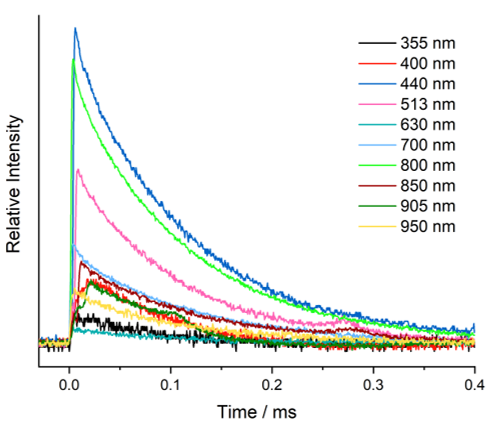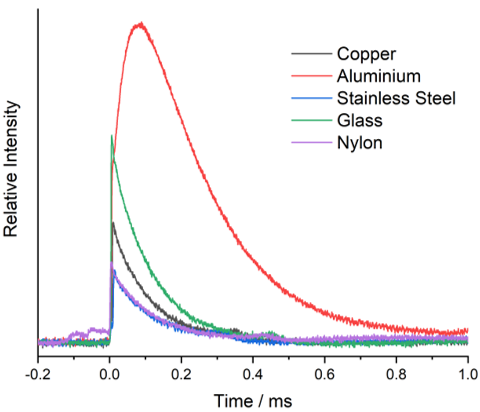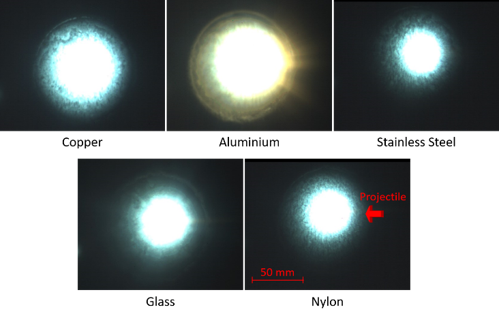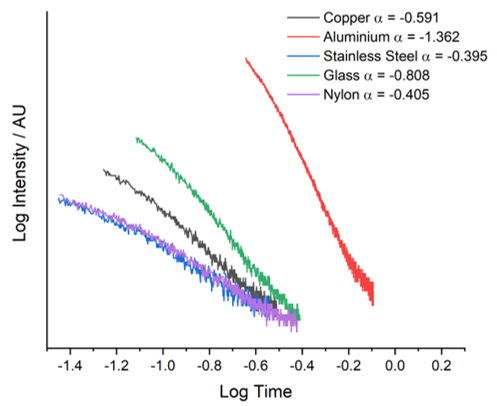The Effect of Projectile Material on the Impact Flash from Carbon Dioxide Ice
- 1London Metropolitan University, School of Human Sciences, United Kingdom of Great Britain and Northern Ireland (j.tandy@londonmet.ac.uk)
- 2School of Physical Sciences, Ingram Building, University of Kent, Canterbury, CT2 7NH
- 3Laboratoire Lagrange, Observatoire de la Côte d’Azur, UCA, France
- 1London Metropolitan University, School of Human Sciences, United Kingdom of Great Britain and Northern Ireland (j.tandy@londonmet.ac.uk)
- 2School of Physical Sciences, Ingram Building, University of Kent, Canterbury, CT2 7NH
- 3Laboratoire Lagrange, Observatoire de la Côte d’Azur, UCA, France
Introduction
The self-luminous plume (or ‘flash’) resulting from hypervelocity impacts onto planetary bodies are readily observed (even for relatively small-scale impacts) [1-3], despite the radiative decay of the impact-induced emission being relatively short-lived. The replication and measurement of such impact events in the laboratory is critical to gain a deeper understanding of the wavelength dependence and dynamic behaviour of impact flashes from icy bodies and contribute towards a thorough assessment of the physical and chemical processes these frozen systems are exposed to. The temporal evolution of impact flashes are often measured in the laboratory using photodetectors, e.g. [4-6] or high-speed cameras, e.g. [6-9], and reveal multiple phases of the radiating ejecta. The behaviour of emission during these phases are dependent upon several parameters including target composition and porosity, projectile material, impact speed and angle [6,8,10]. This study examined the wavelength dependence and temporal variation of the hypervelocity impact flash from CO2 ice targets using a variety of projectiles.
Experimental
The Kent two-stage light-gas gun was used to horizontally accelerate projectiles (Table 1) into CO2 ice targets compressed into 100 mm diameter, stainless steel cans with their surface aligned at 90o to the shot line. Targets were stored at approximately -140 oC prior to impact to prevent significant CO2 ice sublimation. Experiments used impact speeds between 4.6 and 5.0 km/s (Table 1), with the target chamber evacuated to ~50 mbar during each shot.
Table 1 – Experimental parameters for impact flash measurements
The impact flash decay was monitored across ten spectral bands (between 355 nm and 950 nm) using an array of identical photodiodes, with different optical/IR band-pass filters. Photodiodes were placed slightly below the shot line within the target chamber, approximately 650 mm from target surface, with a field of view of approximately 25 cm at the point of impact. The resulting emission intensity data have a time resolution of 1.0 µs and were adjusted for the quantum efficiency of the photodiodes and normalised according to the transmission efficiency at the central wavelength of each band-pass filter. Photographs of the impact flash were recorded through a window in the target chamber approximately 1.1 m and 15˚ from the projectile shot line using a ‘High Speed Camera Company’ FPS2000 digital video camera utilising a 50 mm Nikon f1.2 lens with a resolution of 1024 x 360. The camera was operated continuously at 2800 frames/s and selected frames extracted post-shot.
Results and Conclusions
Figure 1 illustrates the variation in flash decay profile observed for each photodiode using the 3.0 mm diameter glass projectile, indicating a wavelength dependence previously observed for aluminium impacts onto ices [11]. Additional variations between photodiode channels were detected for all other projectile materials, with the largest differences observed using aluminium (shown in Figure 2) for the 440 nm photodiode channel. The high-speed photographs in Figure 3 also show the significant difference in impact flash colour and shape when using the aluminium projectile. The orange-yellow colour originates from strong zinc atomic emission (~ 6% Zn in Al-7075) at 624 nm, 636 nm and 648 nm within the ejecta plume [12].

Figure 1 – Flash decay measurements from a 3.0 mm diameter sodalime glass projectile impacting CO2 ice at 4.73 km/s.

Figure 2 – A comparison of the impact emission profile for the 440 nm photodiode channel using different projectile materials.

Figure 3 – A comparison of impact flash photographs using different projectile materials.
Analyses of the emission profiles for the 440 nm and 800 nm channels were used to calculate decay exponents (α) for each projectile material as described by Ernst and Schultz [13] and are shown in Figures 4 and 5. For projectiles other than aluminium, there is a good agreement in the calculated α values (< 0.035 difference), demonstrating a consistency in the behaviour of flash decay across the visible region. However, the α values for the aluminium projectile differ by 0.077, which may be due to influence from AlO emission within the 440 nm photodiode region [14].

Figure 4 – Decay curves and exponents (α) from the 440 nm photodiode data for each projectile material.
Figure 5 – Decay curves and exponents (α) from the 800 nm photodiode data for each projectile material.
These observations highlight the importance of using a broad range of parameters when replicating impact events in the laboratory and may provide a useful comparison for future observations of impact flashes on icy bodies.
Acknowledgements
MCP, PJW, MJC and JT thank the STFC for funding assisting this work. LA acknowledges receipt of a University of Kent GTA Scholarship. CA thanks ESA Science Faculty grant for funding the detection instrument. The work of CA was supported by the French National Research Agency under the project “Investissements d’Avenir” UCAJEDI (ANR-15-IDEX-01).
References
[1] D.W. Dunham et al., 2000, 31st LPSC, #1547.
[2] B.M. Cudnik et al., 2003, Earth, Moon and Planets, 93, 145.
[3] M. Delcroix & R. Hueso. 2013, EPSC, #EPSC2013-812-1.
[4] M.J. Burchell et al., 1996, Icarus, 122, 359-365.
[5] H. Yafei et al., 2019, Int. J. Impact. Eng., 125, 173-179.
[6] C.M. Ernst & P.H. Schultz, 2007, Icarus, 190, 334-344.
[7] J.M. Mihaly et al. 2015, J. Appl. Mech. 82, 011004.
[8] P.H Schultz & C.A. Eberhardy, 2015, Icarus, 248, 448-462.
[9] J.D. Tandy et al., 2014, J. Appl. Phys., 116, 034901.
[10] J.A. Ang, 1990, Int. J. Impact Eng., 10, 23-33.
[11] J.D. Tandy et al., 2019, EPSC-DPS, 13, 2019-1897-1.
[12] NIST ASD Team et al., 2019, NIST Atomic Spectra Database (ver. 5.7.1), https://physics.nist.gov/asd.
[13] C.M. Ernst & P.H. Schultz, 2003, Lunar Planet. Sci. XXXIV. Abstract 2020.
[14] R.W.B. Pearse & A.G. Gaydon, 1976, The Identification of Molecular Spectra (4th ed.), Chapman and Hall, New York.
How to cite: Tandy, J., Price, M., Wozniakiewicz, P., Cole, M., Alesbrook, L., and Avdellidou, C.: The Effect of Projectile Material on the Impact Flash from Carbon Dioxide Ice, Europlanet Science Congress 2020, online, 21 Sep–9 Oct 2020, EPSC2020-144, https://doi.org/10.5194/epsc2020-144, 2020.

